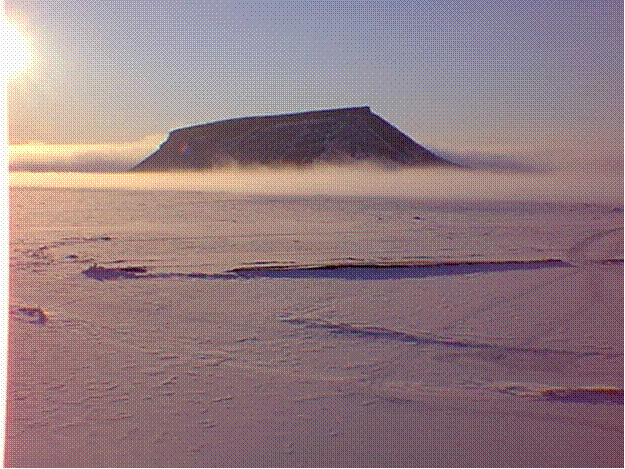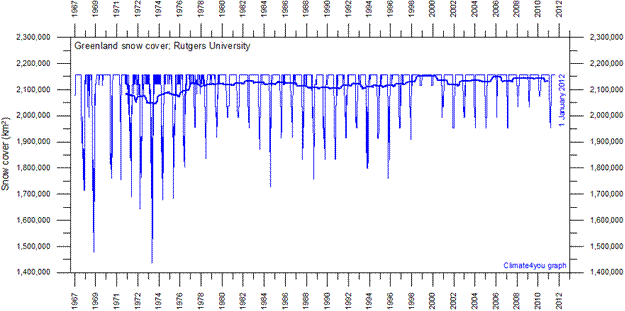Greenland Is Turning White
By Ed Caryl
“No place on Earth is warming as fast as Greenland,” we keep hearing. Or: “Greenland is approaching a tipping point!”
Figure 1: Dundas Mountain and Northstar Bay at Thule AFB, Northern Greenland. Photo by Ed Caryl
The Arctic is known as a desert, with little rain or snow, winter or summer. When I was at Thule AFB in 1962 – 63, snow accumulation was a few inches each winter, and most of that was blown in from the ice cap. In more recent years, however, the snowfall at Thule has increased.
Figure 2 is a photo from 1996 (local noon on that date). Photo by Ed Caryl
Over the recent years we have been inundated by media reports that Greenland is losing ice at a rapid rate, raising sea-levels, etc, etc. But what is really happening? To find out, look at the following chart from Rutgers University:
Figure 3: Greenland snow cover from Rutgers University Global Snow Laboratory website. ww.climate4you.snowcover.htm
The plateau at the top of the chart depicts complete snow cover, 100%. Note how the trend is clearly steadily up.
Greenland is approaching a condition of year-around complete snow cover.
Is this getting reported in the media? I wonder what condition triggers an ice age?








No doubt it won’t be reported by the MSM, just as the increase in Antarctic ice goes unreported.
The UN must demand that the west increase it’s CO2 emissions, and commence the strategic bombing of the poles with carbon black??
We already do that.
http://earthsky.org/earth/international-effort-launched-to-track-black-carbon-in-the-arctic
The problem is, we don’t, with any certainty, know the source. Some people blame China’s coal burning, but a study shows the BC doesn’t make it out of China.
http://journals.ametsoc.org/doi/pdf/10.1175/2010BAMS3064.1
In 1962-63, the air at Thule was crystal clear. You could see 100 miles from J-site, and terrain at the horizon was as clear as that a mile away. That is no longer true. The stuff comes from somewhere. NOAA has a current effort to find out where.
http://www.noaanews.noaa.gov/stories2011/20110418_blackcarbon.html
Thanks for the links Ed.
Of course my comment about CO2 and Carbon Black was “tongue in cheek”. But maybe when some day the onset of the next glacial period becomes reality, perhaps fiddling with the albedo of the planet should be one of the responses considered. We’d be fools to try to interfere with the slight and beneficial warming experienced during the last century or two, but a return to the more usual temperatures of an ice-age is a very different matter.
The onset of the next interglacial – maybe Sir Fred Hoyle’s take on this is as good as anyone’s, who knows:
“The interglacial climate possesses only neutral equilibrium however. It experiences random walk both up and down, until a situation arises in which the number of steps downward become sufficient for the Earth to fall back into the ice-age trap.”
http://abob.libs.uga.edu/bobk/ccc/ce120799.html
The next (& concluding) sentence reads: “Thereafter only a further large bolide impact can produce a departure from the grey, drab iceage conditions. This will be so in the future unless Man finds an effective way to maintain a suitably large greenhouse effect.” (Copyright 1999, Fred Hoyle and Chandra Wickramasinghe).
So this is, one would guess from the late date, about 95% Wickramasinghe – not someone noted for being on the right track. Not that Sir Fred hat such a good track record himself; he was right about nucleosynthesis, of course, but I wonder how much of the actual work in the 1957 B2FH paper was actually done by him – he was the one who did not get a Nobel for that (he attributed that to academic nastiness; he may have been right).
Now wonder sea level is dropping. Too much snow in Greenland.
I think the next ice age is here.
Bob and Bruce:
We will see.
Please, gentlemen, don’t spoil my day. I was just enjoying that little bit of local warming here and my tropical plants are still outside on the balcony.
Forecast for Germany : Temperature drop to 0 deg C til saturday! You might want to get them inside.
http://wetterstationen.meteomedia.de/station=103480&wahl=vorhersage
The increase in snow in Greenland is caused by – of course, what else – global warming. See the NASA page
http://www.nasa.gov/vision/earth/environment/ice_sheets.html
Unfortunately the same website has an article reporting record melting of Greenland snow,
http://www.nasa.gov/vision/earth/environment/greenland_recordhigh.html
Yet the area without snow is decreasing. The rock must be melting!
Any melting there, as well aa in many other places of the globe would just be a recovery from the little ice age, since temperatures are currently close to the average of the last 4000 years.
http://wattsupwiththat.com/2011/11/10/new-study-shows-temperature-in-greenland-significantly-warmer-than-present-several-times-in-the-last-4000-years/